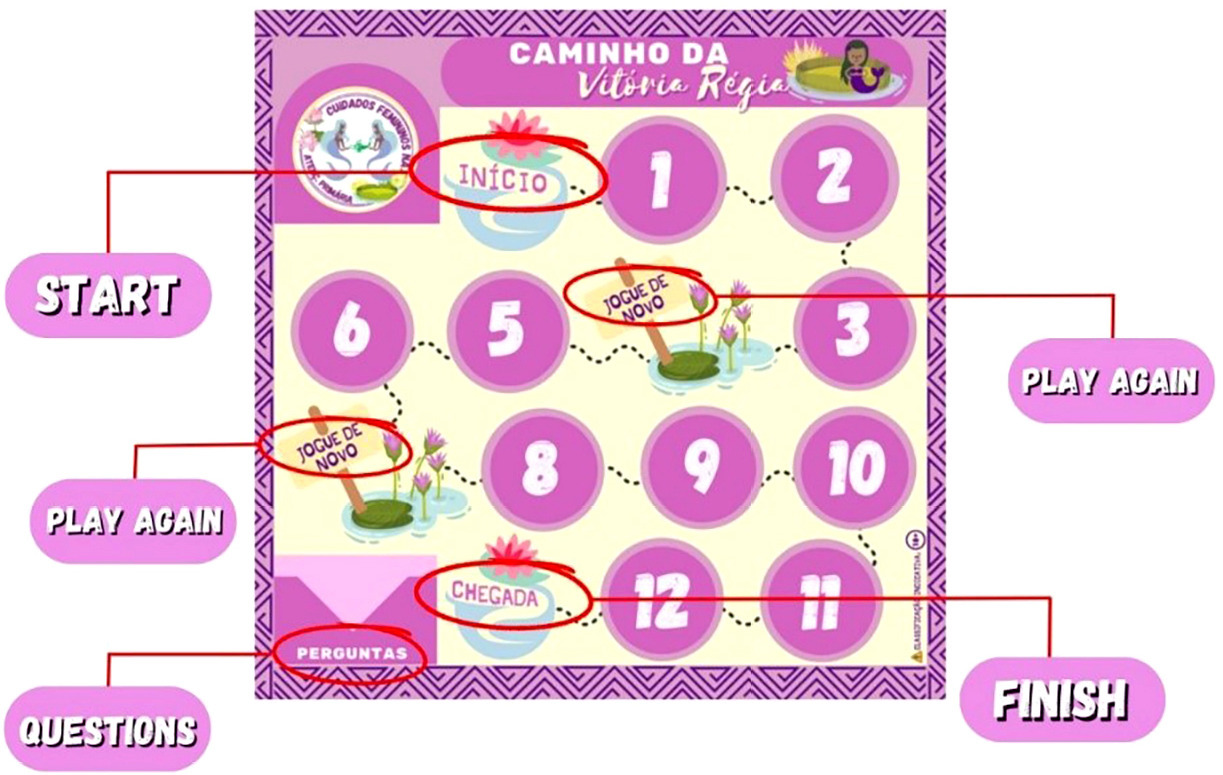-
RESEARCH01-01-2016
Nasal colonization with Staphylococcus aureus in nursing students: ground for monitoring
Revista Brasileira de Enfermagem. 2016;69(6):1046-1051
Abstract
RESEARCHNasal colonization with Staphylococcus aureus in nursing students: ground for monitoring
Revista Brasileira de Enfermagem. 2016;69(6):1046-1051
DOI 10.1590/0034-7167-2016-0210
Views0See moreABSTRACT
Objective:
to monitor bacterial strains of Staphylococcus aureus that are resistant or not to oxacillin in nursing undergraduate students, with an emphasis on the process of colonization.
Method:
cross-sectional prevalence study carried out with 138 nursing students. The biological samples of the nasal cavity were collected in June 2015, by means of sterile swabs, which were subsequently submitted to confirmatory tests of catalase and coagulase. Isolated Staphylococcus aureus had their sensitivity profile determined by means of the Kirby Bauer method. Descriptive, univariate and bivariate analyses were performed.
Results:
the prevalence of Staphylococcus aureus was 21.7. Regarding the resistance profile, 24.1% of strains were resistant to oxacillin, with ampicillin being the antimicrobial with the greatest resistance (82.8%).
Conclusion:
the nasal cavity is an important bacterial flora of S. aureus in nursing students. The profile of isolated strains highlights the increase of Staphylococcus aureus resistance to antimicrobials such as oxacillin.
-
RESEARCH01-01-2016
Factors associated with the occurrence of adverse events in critical elderly patients
Revista Brasileira de Enfermagem. 2016;69(6):1039-1045
Abstract
RESEARCHFactors associated with the occurrence of adverse events in critical elderly patients
Revista Brasileira de Enfermagem. 2016;69(6):1039-1045
DOI 10.1590/0034-7167-2016-0199
Views0See moreABSTRACT
Objective:
to identify the factors associated with the occurrence of adverse events in critical elderly patients admitted to intensive care unit according to demographic and clinical characteristics.
Method:
a retrospective cohort study was conducted in nine units of a teaching hospital. Data were collected from medical records and from monitoring of nursing shift change. We used the t-test/Mann-Whitney, chi-square and logistic regression to test associations. Significance level of 5% was used.
Results:
out of the 315 elderly, 94 experienced events. Those who experienced events were men (60.6%) with mean age of 70.7 years, length of hospital stay of 10.6 days and survivors (61.7%). Most of the 183 events were clinical processes and procedures (37.1%). There was an association between adverse event and length of hospital stay in the unit (p=0.000; OR=1.10, 95% CI [1.06, 1.14]).
Conclusion:
the identification of associated events and factors in the elderly subsidize the prevention of these occurrences before the vulnerability of this age group.
-
RESEARCH01-01-2016
Challenges to implementation of advance directives of will in hospital practice
Revista Brasileira de Enfermagem. 2016;69(6):1031-1038
Abstract
RESEARCHChallenges to implementation of advance directives of will in hospital practice
Revista Brasileira de Enfermagem. 2016;69(6):1031-1038
DOI 10.1590/0034-7167-2016-0085
Views0See moreABSTRACT
Objective:
to understand the difficulties and limitations in the implementation of advance directives of will in the hospital context.
Method:
qualitative, exploratory and descriptive study conducted by means of semi-structured interviews with nurses, resident physicians and family caregivers. The data were analyzed by using discursive textual analysis based on the framework of bioethics principles.
Results:
the following categories emerged: Terminality as an expression of loss and cure as an option for care; concerns about legal implications; advance directives of will demand patient autonomy and proper communication.
Conclusion:
limitations and difficulties in practice of advance directives of will from the perspective of the participants show, apart from countless conflicts and dilemmas regarding end-of life matters, that impending death experiences obstruct patients’ wishes.
-
RESEARCH01-01-2016
Experience and coping strategies in relatives of addicts
Revista Brasileira de Enfermagem. 2016;69(6):1024-1030
Abstract
RESEARCHExperience and coping strategies in relatives of addicts
Revista Brasileira de Enfermagem. 2016;69(6):1024-1030
DOI 10.1590/0034-7167-2015-0044
Views0See moreABSTRACT
Objective:
to understand the experience and coping strategies in relatives of drug addicts.
Method:
a study was developed with 87 relatives of addicts, registered in two Basic Health Units. The focus group was used as the study method, and content analysis was applied.
Results:
four categories were chosen: perception of relatives about the drug addiction of their family members; feelings and attitudes related to being a relative of an addict; difficulties found in the process; and, coping strategies. The findings reflected the difficulty when mentioning the subject, and the need of being cared for. Relatives believed that the addict needs to have the will to get into treatment, and they faced challenges in dealing with sporadic disappearances. They pointed to feelings of pity, impotence, disgust, hate, shame, fear of aggressiveness, and humiliation.
Conclusion:
the biggest difficulties were dealing with relapses, and the lack of public resources. Religiosity and faith, isolation and advice were used as coping strategies; ambivalence in thoughts and attitudes was demonstrated.
-
RESEARCH01-01-2016
Leadership and cooperation: 25 years of mission as a WHO collaborating center
Revista Brasileira de Enfermagem. 2016;69(6):1017-1023
Abstract
RESEARCHLeadership and cooperation: 25 years of mission as a WHO collaborating center
Revista Brasileira de Enfermagem. 2016;69(6):1017-1023
DOI 10.1590/0034-7167-2016-0058
Views0See moreABSTRACT
Objective:
analyse the evolution in the mission and vision of a World Health Organization Collaborating Centre in Nursing in Brazil in the context of the implementation of its terms of reference.
Method:
Historical-social documentary research with a qualitative approach.
Results:
During the 25 years of its activities as a Collaborating Centre, its mission to “promote and stimulate the development of nursing research in the region, with a focus on Latin America” triggered activities in the context of its terms of reference in four areas: Human Resource Formation for Research, Knowledge Production, Knowledge Dissemination, Encouragement of Exchange and Stimulus of Partnerships.
Conclusion:
The activities developed were consolidated through the strengthening of Brazilian and international partnerships, further stimulated by the five redesignations of the Collaborating Centre in the period analysed. Thus, its vision of becoming leader and driving agent of innovations in the academic, care and political context of nursing could be put in practice.
-
EDITORIAL01-01-2016
ABEn 90 years and the Brazilian Journal of Nursing
Revista Brasileira de Enfermagem. 2016;69(6):1011-1012
Abstract
EDITORIALABEn 90 years and the Brazilian Journal of Nursing
Revista Brasileira de Enfermagem. 2016;69(6):1011-1012
Views0In this special edition, we celebrate 90 years of the Brazilian Nursing Association (ABEn), at the same time in which we celebrate the creation and maintenance of the first scientific nursing journal in Brazil. Emerging in 1932, it has shone a light on the production of knowledge and the constitution of nursing in Brazil today.As […]See more -
EDITORIAL01-01-2016
ABEn 90 anos e a Revista Brasileira de Enfermagem
Revista Brasileira de Enfermagem. 2016;69(6):1011-1012
Abstract
EDITORIALABEn 90 anos e a Revista Brasileira de Enfermagem
Revista Brasileira de Enfermagem. 2016;69(6):1011-1012
Views0Neste número temático, celebramos os 90 anos da Associação Brasileira de Enfermagem (ABEn), ao mesmo tempo em que comemoramos a criação e manutenção da primeira revista científica de enfermagem do Brasil, que, desde 1932, despontou trazendo luz para a produção do conhecimento e a constituição do que é a enfermagem no Brasil atual.A ABEn, como […]See more -
ERRATUM01-01-2016
ERRATUM
Revista Brasileira de Enfermagem. 2016;69(5):1003-1003
Abstract
ERRATUMERRATUM
Revista Brasileira de Enfermagem. 2016;69(5):1003-1003
DOI 10.1590/0034-7167.20166905e02
Views1Article “Association between self-care and hospital readmissions of patients with heart failure”, with number of DOI: 10.1590/0034-7167.2016690312i, published in the journal Revista Brasileira de Enfermagem, v69(3):469-74, page 469 that read:“Amanda Chlalup LinnI, Karina AzollinII,III, Emiliane Nogueira de SouzaII,IV“.[…]See more
-
ORIGINAL ARTICLE07-19-2024
Validation of an instrument for assessing leprosy care in children and adolescents
Revista Brasileira de Enfermagem. 2024;77(2):e20230344
Abstract
ORIGINAL ARTICLEValidation of an instrument for assessing leprosy care in children and adolescents
Revista Brasileira de Enfermagem. 2024;77(2):e20230344
DOI 10.1590/0034-7167-2023-0344
Views0See moreABSTRACT
Objectives:
to validate the content of an instrument for assessing leprosy care in individuals under 15 years old in the context of Primary Health Care.
Methods:
methodological study of content validation, based on the evaluation of essential and derived attributes in primary care, in the professional version. For data analysis, the Content Validation Index (CVI ≥ 0.8) and Cronbach’s Alpha were calculated.
Results:
a higher percentage of judges among nurses (61.5%) was observed; with a doctorate (46.2%), and engaged in teaching and research (77%). The overall Content Validation Index of the instrument was 0.98. In the analysis of Cronbach’s Alpha of the instrument, the assigned value was 0.717.
Conclusions:
the instrument represents an advancement in the measurement of health evaluation policies and can significantly contribute to improving the quality of care provided to children and adolescents with leprosy.
-
ORIGINAL ARTICLE07-19-2024
Validation of the Brazilian Version of the Modified Scale for Delineating Advanced Practice Nursing Roles
Revista Brasileira de Enfermagem. 2024;77(2):e20230211
Abstract
ORIGINAL ARTICLEValidation of the Brazilian Version of the Modified Scale for Delineating Advanced Practice Nursing Roles
Revista Brasileira de Enfermagem. 2024;77(2):e20230211
DOI 10.1590/0034-7167-2023-0211
Views0See moreABSTRACT
Objectives:
to validate the Brazilian version of the Modified Scale for Delineating Advanced Practice Nursing Roles.
Methods:
this was a methodological study for the clinical validation of an instrument, conducted with 207 nurses working in primary care. Exploratory and confirmatory factor analysis, Cronbach’s alpha test, and z-test for proportion comparison were used.
Results:
the internal reliability of the scale was 0.944, with alpha greater than 0.80 in most domains, except for Education (0.786). In the exploratory factor analysis, considering the criterion of eigenvalue greater than one, eight factors were identified, explaining 79.38% of the variance. In the comparison of proportions, the adequate responses (≥ 2) in the domain of Comprehensive Direct Care, in both analyzed groups, were statistically equal. This domain had the highest score of adequate responses, followed by Education and Systems Support. Insufficient scoring was observed in the domains of Publication and Professional Leadership.
Conclusions:
the instrument demonstrated stability and reliability to be used in the evaluation of advanced nursing practice.
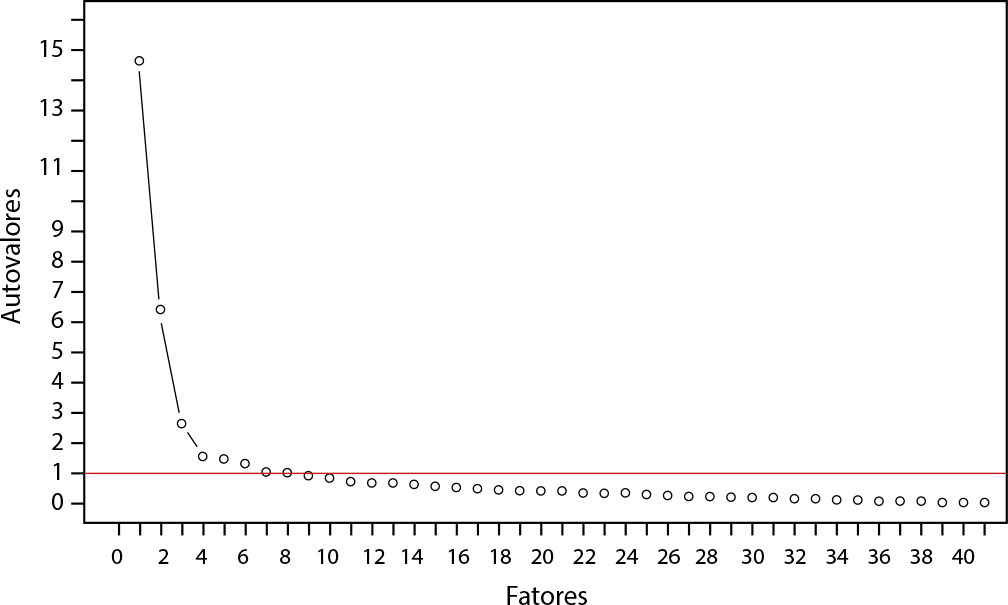
-
REVIEW07-19-2024
Nursing care for hospitalized older adults – fall accidents versus safe mobility: a scoping review
Revista Brasileira de Enfermagem. 2024;77(2):e20230180
Abstract
REVIEWNursing care for hospitalized older adults – fall accidents versus safe mobility: a scoping review
Revista Brasileira de Enfermagem. 2024;77(2):e20230180
DOI 10.1590/0034-7167-2023-0180
Views0See moreABSTRACT
Objectives:
to map the constituent elements of the safe mobility concept present in hospital care for older adults.
Methods:
a scoping review of 35 articles searched in databases and gray literature – BDENF/VHL, Scopus, CINAHL/EBSCO, Embase, Web of Science, PEDro, MEDLINE/PubMed and CAPES Theses and Dissertations Catalog. No time or language cut-off was established.
Results:
none of the studies presented a clear safe mobility concept, however its constituent elements involve factors related to patient (behavioral factors, conditions, diseases, signs and symptoms, nutritional status, age, balance, strength, gait quality, sleep), the institution (environment, treatment devices, guidelines, medications and polypharmacy, material and human resources and clothing/shoes) and the nature of the interventions (related to the patient, institution and family).
Final Considerations:
the constituent elements of safe mobility express hospital units’ capacity to guarantee care and protection from fall accidents for hospitalized older adults.
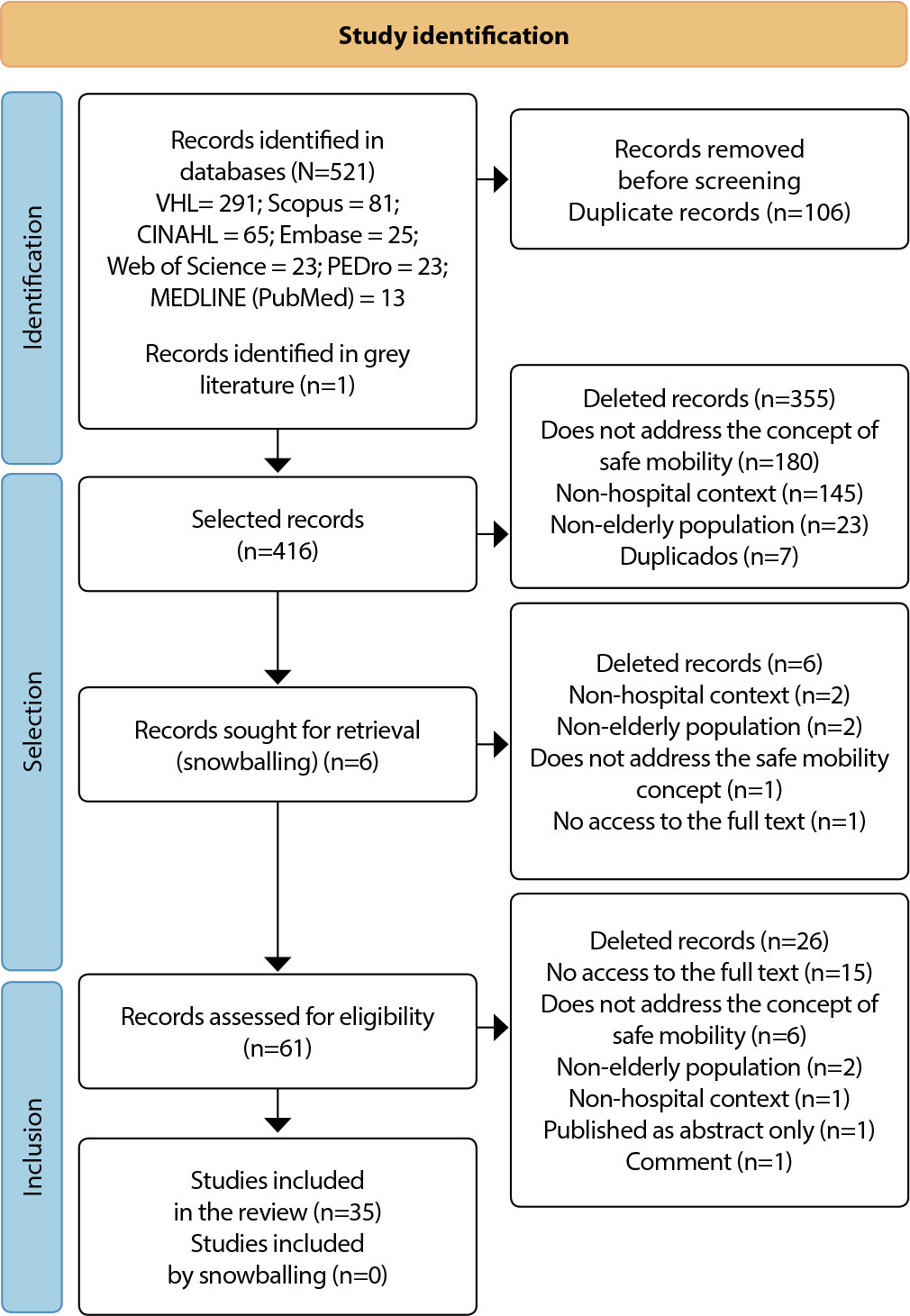
-
REVIEW07-19-2024
Drug-resistant tuberculosis: integrative review of nursing care in primary health care
Revista Brasileira de Enfermagem. 2024;77(2):e20230097
Abstract
REVIEWDrug-resistant tuberculosis: integrative review of nursing care in primary health care
Revista Brasileira de Enfermagem. 2024;77(2):e20230097
DOI 10.1590/0034-7167-2023-0097
Views0See moreABSTRACT
Objectives:
to identify, in the scientific literature, the care that should be provided to individuals with drug-resistant tuberculosis by nurses in primary health care.
Methods:
integrative review, using the Preferred Reporting Items for Systematic Reviews and Meta-Analyses study selection flowchart. Data collection was conducted in November 2022, across ten databases.
Results:
six studies emphasized that nurses should perform directly observed treatment; two highlighted the importance of integrated care management between tuberculosis and human immunodeficiency virus; two demonstrated comprehensive nursing consultation using the nursing process; one emphasized person-centered care, with discharge planning and improved hospital communication with primary health care services.
Final Considerations:
the care that nurses should provide to individuals with drug-resistant tuberculosis in primary health care, for care resolution, is evidence-based.
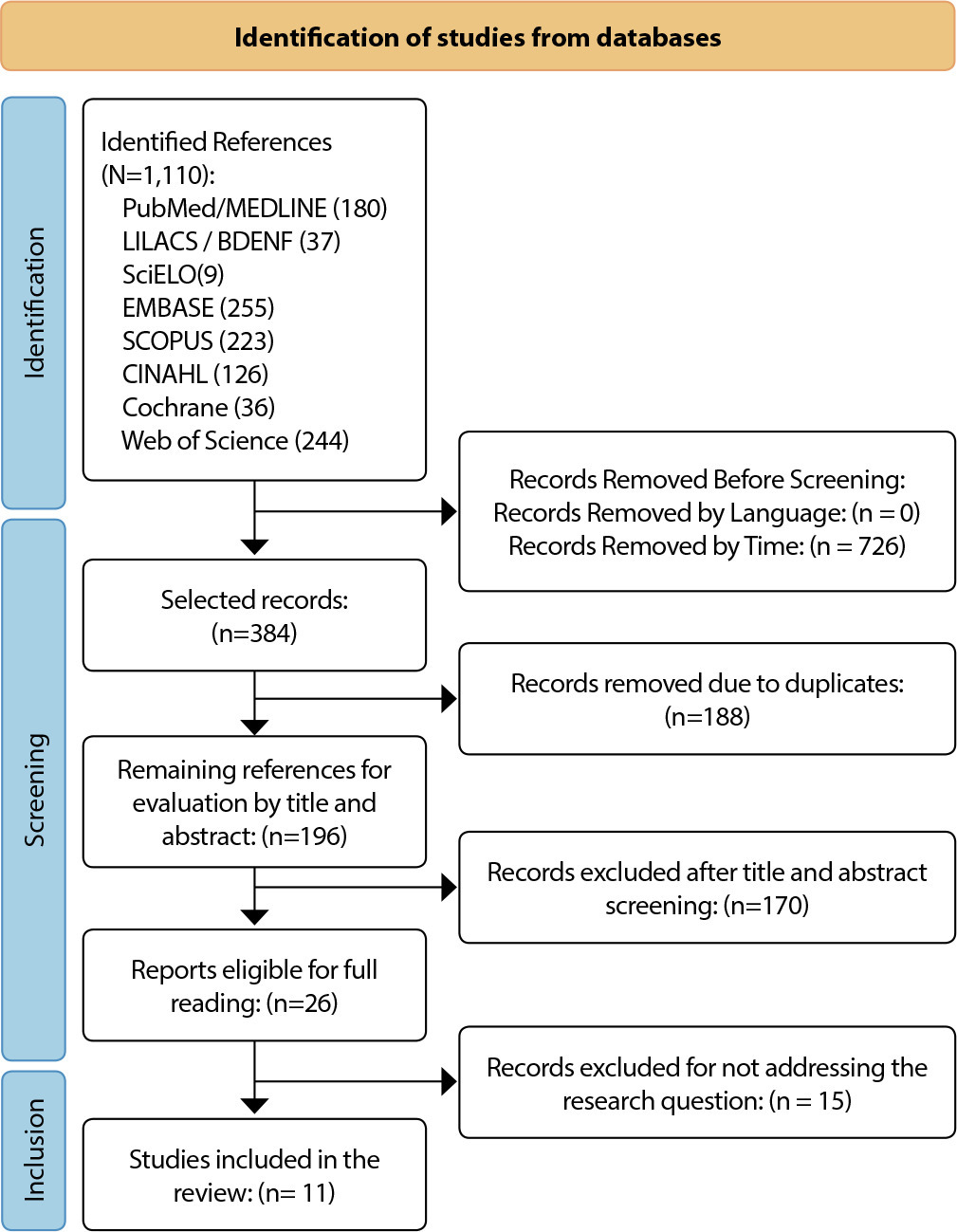
-
ORIGINAL ARTICLE07-19-2024
Translation and cross-cultural adaptation of the MISSCARE Survey-Ped into Brazilian Portuguese
Revista Brasileira de Enfermagem. 2024;77(2):e20230060
Abstract
ORIGINAL ARTICLETranslation and cross-cultural adaptation of the MISSCARE Survey-Ped into Brazilian Portuguese
Revista Brasileira de Enfermagem. 2024;77(2):e20230060
DOI 10.1590/0034-7167-2023-0060
Views0See moreABSTRACT
Objectives:
to translate and cross-culturally adapt the MISSCARE Survey-Ped for use in Brazil.
Methods:
a methodological study proposed by translation, synthesis of translations, back-translation, assessment by a committee of experts and pre-testing with the target population.
Results:
two direct translations of the instrument were carried out, followed by a consensual version between them. This synthetic version was back-translated and analyzed by a committee of five experts in pediatric nursing and patient safety, obtaining a Content Validity Index (CVI) of 0.95 and Cronbach’s alpha of 0.804. The final version was sent for pre-testing with 254 Brazilian pediatric nurses, with 44 (17.3%) analyzing the instrument for understanding (CVI 0.866; Content Validity Ratio (CVR) 0.773), relevance (CVI 0.931; CVR 0.864) and relevance (CVI 0.977; CVR 0.955).
Conclusions:
the MISSCARE Survey-Ped Brasil was considered suitable for application in pediatric nurses’ clinical practice in the country.
-
EDITORIAL07-15-2024
Invisibilidade do trabalho da enfermagem: tecnologia como via de combate
Revista Brasileira de Enfermagem. 2024;77:e77suppl0301
Abstract
EDITORIALInvisibilidade do trabalho da enfermagem: tecnologia como via de combate
Revista Brasileira de Enfermagem. 2024;77:e77suppl0301
DOI 10.1590/0034-7167.202477suppl0301pt
Views0Na concepção comum, o trabalho é comumente associado a uma atividade remunerada em uma sociedade mercantil e de direito, refletindo a visão moderna que o limita ao tempo trocado por salário. Essa perspectiva, influenciada pelos princípios da Revolução Industrial, estabelece uma dicotomia entre o trabalho e o tempo fora dele, segmentando a vida em esferas […]See more -
EDITORIAL07-15-2024
Invisibility of nursing work: technology as a means of combat
Revista Brasileira de Enfermagem. 2024;77:e77suppl0301
Abstract
EDITORIALInvisibility of nursing work: technology as a means of combat
Revista Brasileira de Enfermagem. 2024;77:e77suppl0301
DOI 10.1590/0034-7167.202477suppl0301
Views0In the common conception, work is commonly associated with a paid activity in a commercial and legal society, reflecting the modern view that limits it to time exchanged for wage. This perspective, influenced by Industrial Revolution principles, establishes a dichotomy between work and time outside of work, segmenting life into professional and private spheres. However, […]See more
-
EDITORIAL03-08-2024
A enfermagem como protagonista no enfrentamento da hesitação e recusa vacinal
Revista Brasileira de Enfermagem. 2024;77:e77suppl101
Abstract
EDITORIALA enfermagem como protagonista no enfrentamento da hesitação e recusa vacinal
Revista Brasileira de Enfermagem. 2024;77:e77suppl101
DOI 10.1590/0034-7167.202477suppl101pt
Views0Desde a década de 1970, o Ministério da Saúde do Brasil instituiu o Programa Nacional de Imunização (PNI), que precedeu o Sistema Único de Saúde e que lhe foi incorporado e fortalecido, devido ao modelo descentralizado aos municípios, mas de comando único ao nível central. Seu objetivo era e ainda é coordenar as ações de […]See more -
EDITORIAL03-08-2024
Nursing as a player in tackling vaccine hesitancy and refusal
Revista Brasileira de Enfermagem. 2024;77:e77suppl101
Abstract
EDITORIALNursing as a player in tackling vaccine hesitancy and refusal
Revista Brasileira de Enfermagem. 2024;77:e77suppl101
DOI 10.1590/0034-7167.202477suppl101
Views1Since the 1970s, the Brazilian Ministry of Health established the Brazilian National Immunization Program (PNI – Programa Nacional de Imunização), which preceded the Brazilian Health System and which was incorporated and strengthened due to the decentralized model to municipalities, but under single command at central level. Its objective was and still is to coordinate vaccination […]See more -
EDITORIAL02-26-2024
Enfermeiro Navegador de Pacientes com Câncer: contribuições para a discussão no cenário nacional
Revista Brasileira de Enfermagem. 2024;77(2):e770201
Abstract
EDITORIALEnfermeiro Navegador de Pacientes com Câncer: contribuições para a discussão no cenário nacional
Revista Brasileira de Enfermagem. 2024;77(2):e770201
DOI 10.1590/0034-7167.2024770201pt
Views0A prática profissional da navegação de pacientes é algo incipiente no Brasil e, sendo assim, é indispensável uma ampla discussão com vários setores da sociedade, sendo essa a principal propositura deste editorial. Comecemos pela história.A navegação de pacientes foi definida em 1989 como uma intervenção de prestação de serviços baseada na comunidade, com o objetivo […]See more -
EDITORIAL02-26-2024
Nurse Navigator of Cancer Patients: contributions to the discussion on the national stage
Revista Brasileira de Enfermagem. 2024;77(2):e770201
Abstract
EDITORIALNurse Navigator of Cancer Patients: contributions to the discussion on the national stage
Revista Brasileira de Enfermagem. 2024;77(2):e770201
DOI 10.1590/0034-7167.2024770201
Views0The professional practice of patient navigation is incipient in Brazil and, therefore, a broad discussion with various sectors of society is essential, which is the main purpose of this editorial. Shall we start with the story.Patient navigation was defined in 1989 as a community-based service delivery intervention aimed at appropriately promoting access to diagnosis and […]See more -
ERRATUM02-26-2024
ERRATUM
Revista Brasileira de Enfermagem. 2024;77(1):e2024n1e02
Abstract
ERRATUMERRATUM
Revista Brasileira de Enfermagem. 2024;77(1):e2024n1e02
DOI 10.1590/0034-7167.20247701e02
Views0In the article “Active teaching model to promote critical thinking”, with DOI number: , published in Revista Brasileira de Enfermagem, 2019;72(1):293-8, on page 297:Include before REFERENCES:[…]See more -
REVIEW02-26-2024
Practice of immersion in hot water to relieve pain in neonatology: an integrative review
Revista Brasileira de Enfermagem. 2024;77(1):e20230260
Abstract
REVIEWPractice of immersion in hot water to relieve pain in neonatology: an integrative review
Revista Brasileira de Enfermagem. 2024;77(1):e20230260
DOI 10.1590/0034-7167-2023-0260
Views0See moreABSTRACT
Objectives:
to identify immersion use in hot water to relieve pain in newborns.
Methods:
an integrative literature review, carried out in the PubMed, VHL, EMBASE, Scopus, CINAHL, Cochrane and SciELO databases, with investigations in English, Spanish, French or Portuguese, published between 2002 and 2022. The Health Sciences Descriptors (DeCS) and Medical Subject Headings (MeSH) were used to answer the following question: what are the uses of hot water immersion in relieving pain in newborns?
Results:
nine studies were included, mainly Brazilian, experimental, with a predominance of strong and moderate levels of evidence. Hydrotherapy and bath use (immersion and bandaging) was observed, promising interventions in reducing pain scores, assessed using scales, physiological and endocrine parameters.
Conclusions:
hot water proved to be a promising non-pharmacological intervention in relieving pain in infants in different contexts.
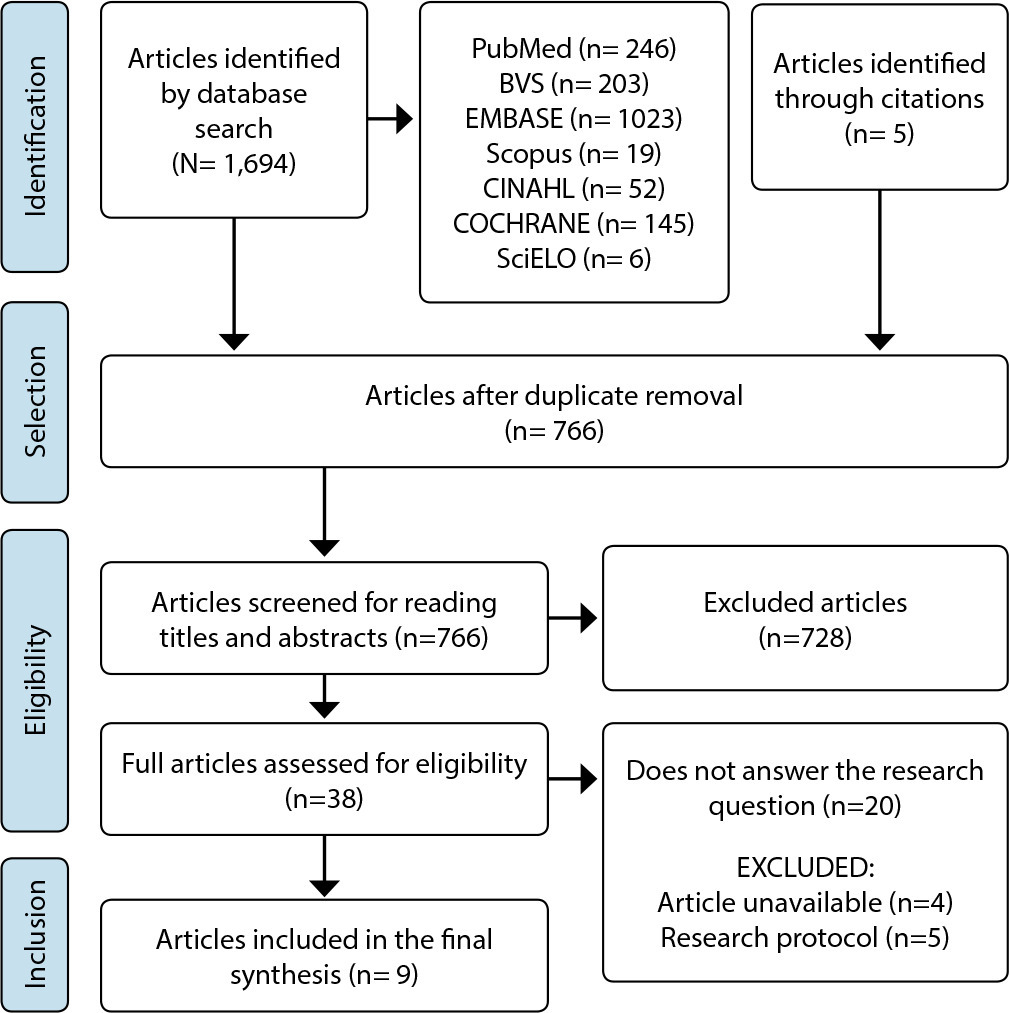
-
ORIGINAL ARTICLE02-26-2024
Artificial intelligence to predict bed bath time in Intensive Care Units
Revista Brasileira de Enfermagem. 2024;77(1):e20230201
Abstract
ORIGINAL ARTICLEArtificial intelligence to predict bed bath time in Intensive Care Units
Revista Brasileira de Enfermagem. 2024;77(1):e20230201
DOI 10.1590/0034-7167-2023-0201
Views0See moreABSTRACT
Objectives:
to assess the predictive performance of different artificial intelligence algorithms to estimate bed bath execution time in critically ill patients.
Methods:
a methodological study, which used artificial intelligence algorithms to predict bed bath time in critically ill patients. The results of multiple regression models, multilayer perceptron neural networks and radial basis function, decision tree and random forest were analyzed.
Results:
among the models assessed, the neural network model with a radial basis function, containing 13 neurons in the hidden layer, presented the best predictive performance to estimate the bed bath execution time. In data validation, the squared correlation between the predicted values and the original values was 62.3%.
Conclusions:
the neural network model with radial basis function showed better predictive performance to estimate bed bath execution time in critically ill patients.
-
REVIEW02-26-2024
Evidence of intrauterine device insertion by nurses in Primary Health Care: an integrative review
Revista Brasileira de Enfermagem. 2024;77(1):e20230134
Abstract
REVIEWEvidence of intrauterine device insertion by nurses in Primary Health Care: an integrative review
Revista Brasileira de Enfermagem. 2024;77(1):e20230134
DOI 10.1590/0034-7167-2023-0134
Views0ABSTRACT
Objectives:
to synthesize and analyze evidence on intrauterine device insertion by nurses in Primary Health Care.
Methods:
an integrative review, carried out in the BDENF, CINAHL, LILACS, SciELO, Scopus, PubMed and Web of Science databases in June 2022, delimiting the period from 1960 to 2022.
Results:
141 articles were identified in the initial search, and 10 studies made up the final sample. Four (40%) were developed in the United States and one (10%) in Brazil, with publications from 1979 to 2021. The findings were grouped into three categories: Nurse training to insert an intrauterine device; Nurses’ competency to insert an intrauterine device; and Women’s access to intrauterine devices.
Conclusions:
nurse theoretical and practical training is a prominent element, consolidated in the favorable outcomes of insertions performed by nurses and satisfaction among women, a practice that has expanded access to the contraceptive method in Primary Health Care.
Keywords:Advanced Practice NursingIntrauterine DevicesLong-Acting Reversible ContraceptionNursesPrimary Health CareSee more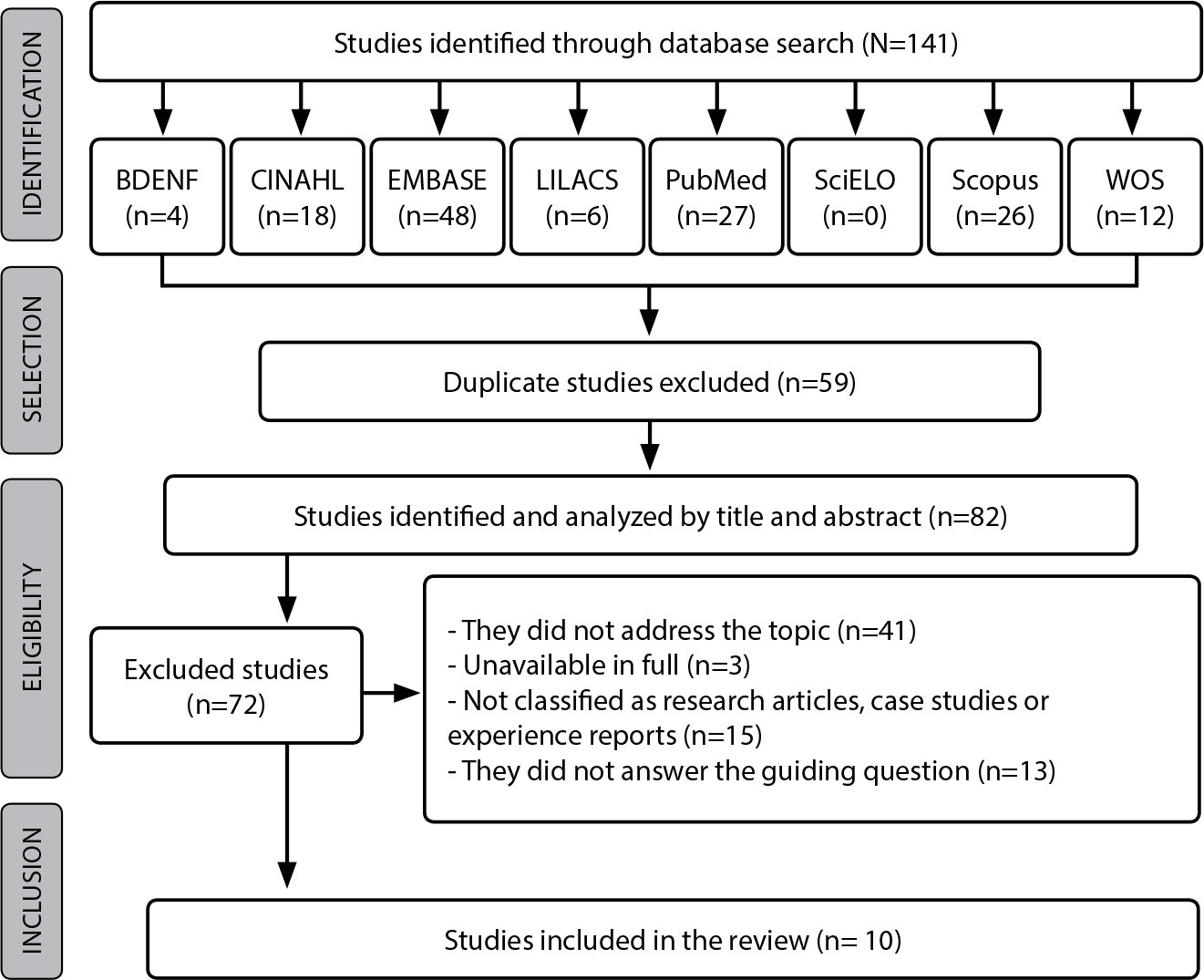
Search
Search in:
Nuvem de Tags
Aged (144) Atenção Primária à Saúde (239) COVID-19 (104) Cuidados de Enfermagem (269) Educação em Enfermagem (151) Educação em Saúde (139) Enfermagem (930) Estudos de Validação (131) Health Education (144) Idoso (208) Mental Health (149) Nursing (987) Nursing Care (306) Patient Safety (151) Primary Health Care (284) Qualidade de Vida (104) Quality of Life (106) Saúde Mental (145) Segurança do Paciente (150) Validation Studies (108)




